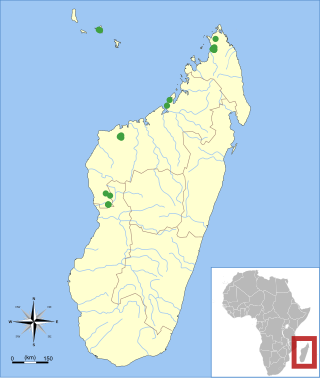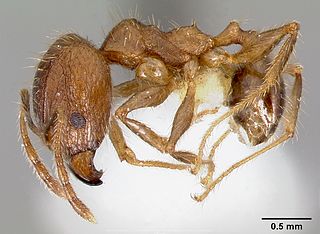
Megatron is a fictional character and the main antagonist of the Transformers media franchise produced by American toy company Hasbro and Japanese toy company Takara Tomy. Megatron is the cruel and tyrannical leader of the Decepticons, a faction of sentient, war-mongering robotic lifeforms that seeks to conquer their home planet of Cybertron and the rest of the known universe. He serves as the archenemy of Optimus Prime, the leader of the rival Autobot faction. As with all Cybertronians, Megatron has the ability to transform between his robot form and various vehicles or weapons. His alternate modes have ranged from a Walther P38 handgun, a particle-beam weapon, a telescopic laser cannon, and a Cybertronian jet, depending on which continuity he is depicted in.

Pheidole is a genus of ants that belongs to the ant subfamily Myrmicinae. The genus is widespread and ecologically dominant. It probably includes more than 1000 species. The genus first evolved in the Americas, eventually spreading across the globe.

Transformers: Revenge of the Fallen is a third-person shooter video game based on the 2009 live action film Transformers: Revenge of the Fallen. It is the sequel to 2007's Transformers: The Game, and the second video game adaptation of the live-action Transformers film series. The PlayStation 3 and Xbox 360 versions of the game were developed by Luxoflux, and ported to Microsoft Windows by Beenox. The PlayStation 2 and Wii versions were developed by Krome Studios, and the PlayStation Portable version was developed by Savage Entertainment. All versions of the game were published by Activision, and released on June 23, 2009 in the United States. Australia received the games one day later, and Europe on June 26. A sequel, Transformers: Dark of the Moon, was released in June 2011, based on the film on the same name.

Diaphoromyrma is a genus of ants in the subfamily Myrmicinae. It contains the single species Diaphoromyrma sofiae, known only from workers from the type locality in Bahia, Brazil. The genus is apparently close to Allomerus and Diplomorium in the Solenopsidini, but its tribal attribution remains uncertain.

Pheidole megacephala is a species of ant in the family Formicidae. It is commonly known as the big-headed ant in the USA and the coastal brown ant in Australia. It is a very successful invasive species and is considered a danger to native ants in Australia and other places. It is regarded as one of the world's worst invasive ant species.

Miniopterus aelleni is a bat in the genus Miniopterus that occurs on Anjouan in the Comoros and in northern and western Madagascar.

Miniopterus griveaudi is a bat in the genus Miniopterus found on Grande Comore and Anjouan in the Comoros and in northern and western Madagascar. First described in 1959 from Grande Comore as a subspecies of the mainland African M. minor, it was later placed with the Malagasy M. manavi. However, morphological and molecular studies published in 2008 and 2009 indicated that M. manavi as then defined contained five distinct, unrelated species, and M. griveaudi was redefined as a species occurring on both Madagascar and the Comoros.

Apterostigma is a genus of New World ants of the subfamily Myrmicinae. Two species have been described from fossils preserved in Dominican amber, while the others are extant. They are fungus-growing ants, though, unlike the majority of other species in Attini who grow Lepiotaceae, some species have begun cultivating Tricholomataceae.
Daceton boltoni is a Neotropical species of arboreal ants in the subfamily Myrmicinae. The species occurs in Peru and Brazil and is similar to its sister species, D. armigerum.
Pheidole komori is a species of ant in the subfamily Myrmicinae.
Pheidole parva is a species of ant in the subfamily Myrmicinae.
Pheidole ragnax is a species of ant in the subfamily Myrmicinae.

Pheidole fervens is a species of ant in the subfamily Myrmicinae. Pheidole fervens, described from Singapore, is a widespread invasive species and could be native to the Oriental or the Oceanic region.

Pheidole teneriffana is a species of ant in the subfamily Myrmicinae.
Pheidole dodo is a species of ant in the subfamily Myrmicinae. It is named after the dodo, an extinct bird of Mauritius.

Pheidole braueri is a species of ant in the subfamily Myrmicinae.
Pheidole loki is a species of ant in the subfamily Myrmicinae.
Pheidole decepticon is a species of ant in the subfamily Myrmicinae.
Pheidole vulcan is a species of ant in the subfamily Myrmicinae.

Pheidole jonas is a species of ant in the subfamily Myrmicinae.











